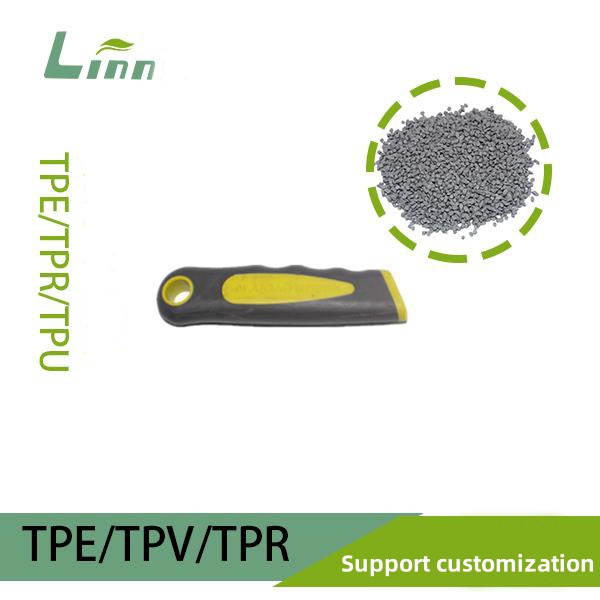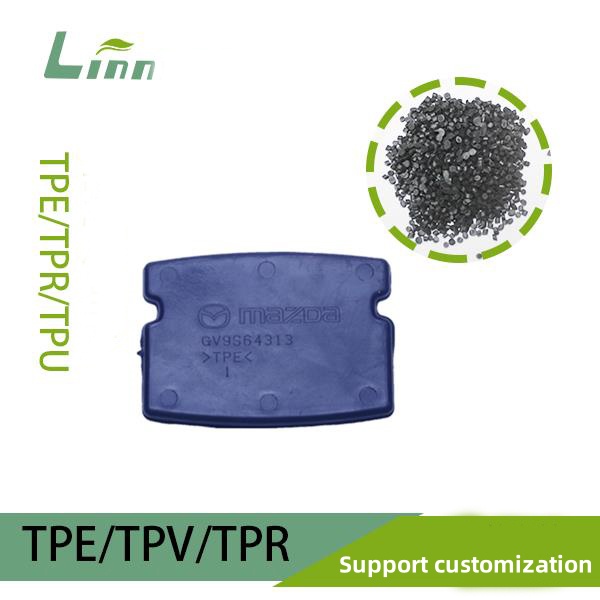As someone who’s been in the materials industry for years, I often get questions about the hardness of TPR (Thermoplastic Rubber). TPR, with its flexibility, abrasion resistance, and eco-friendly properties, is a go-to material for shoe soles, toys, seals, and more. Yet, hardness—one of its core properties—can be a puzzle for newcomers or procurement folks. In this article, I’ll walk you through TPR hardness classifications, measurement methods, and real-world applications, hoping to help you pick the perfect material for your needs!
What Is TPR Material?
Before diving into hardness, let’s quickly cover what TPR is. TPR is a thermoplastic elastomer that blends the elasticity of rubber with the processability of plastic, typically based on **SBS (Styrene-Butadiene–
System: Styrene)** or SEBS (Hydrogenated Styrene-Butadiene-Styrene). It can be processed through injection molding, extrusion, and other methods, making it a staple in both daily life and industrial applications.
Hardness is a critical property of TPR, directly affecting a product’s feel, elasticity, and durability. Different applications demand vastly different hardness levels—for instance, shoe soles need higher hardness for support, while toys might require softer materials for a pleasant touch.
How Is TPR Hardness Measured?
TPR hardness is typically measured using the Shore Hardness scale, a standard designed for testing rubber, elastomers, and soft plastics. Depending on the testing equipment, TPR hardness is divided into several types:
Shore A: Used for softer TPR materials, such as shoe insoles or soft toys.
Shore D: Applied to harder TPR materials, often found in industrial parts or high-strength shoe soles.
Shore 00: Reserved for ultra-soft TPR, like gel pads or medical cushions.
Hardness values range from 0 to 100, with higher numbers indicating harder materials. For example, a Shore A 20 TPR feels as soft as jelly, while Shore A 90 is close to hard plastic.

TPR Hardness Classifications
To give you a clear picture of TPR hardness ranges, I’ve put together a table listing common hardness grades and their typical applications:
|
Hardness Type |
Hardness Range |
Typical Applications |
Tactile Characteristics |
|---|---|---|---|
|
Ultra-Soft (Shore 00) |
0-50 |
Gel pads, shock-absorbing materials, medical supplies |
Soft like jelly, highly elastic |
|
Soft (Shore A) |
20-50 |
Toys, insoles, handle grips |
Soft and comfortable, skin-like feel |
|
Medium-Soft (Shore A) |
50-70 |
Shoe soles, seals, sports equipment |
Balanced elasticity and support |
|
Medium-Hard (Shore A) |
70-90 |
Industrial parts, tire surfaces |
Firm but still slightly elastic |
|
Hard (Shore D) |
30-80 |
High-strength shoe soles, mechanical components |
Close to hard plastic, highly durable |
As the table shows, TPR’s hardness spans a wide range, from ultra-soft to nearly rigid, meeting nearly any flexible material need. The key to choosing the right hardness lies in understanding your product’s function and environment.
Factors Affecting TPR Hardness
In practice, TPR hardness isn’t fixed—it’s influenced by several factors. Here are some key points I’ve learned:
Base Material Formula: SBS-based TPR is typically softer than SEBS-based TPR, as SEBS’s hydrogenated structure offers greater stability and slightly higher hardness.
Filler Content: Adding fillers like calcium carbonate or talc increases hardness but may reduce elasticity.
Processing Techniques: Injection molding temperature and pressure affect molecular alignment, which in turn impacts hardness.
Plasticizer Content: More plasticizers (like mineral oil) make TPR softer, but this can compromise durability.
I recall helping a client troubleshoot a shoe sole material. They aimed for Shore A 60 hardness, but the product came out too soft. Turns out, the plasticizer ratio was too high. After tweaking the formula, we nailed the target. Hardness control is a craft that demands close collaboration between material engineers and production teams.
How to Choose the Right TPR Hardness?
When selecting TPR hardness, I recommend considering these factors:
Define the Product’s Purpose
For shoe soles, a hardness of Shore A 50-70 strikes a balance between support and comfort. For toys, Shore A 30-50 is ideal for softness and safety.
Account for the Use Environment
Outdoor products need higher hardness (Shore A 70+) for abrasion resistance, while indoor items can afford to be softer.
Balance Cost and Performance
Ultra-soft or ultra-hard TPR often requires specialized formulas, driving up costs. If budget is tight, mid-range hardness TPR is a versatile choice.
Test Samples
Hardness is just one metric. Actual feel and performance should be verified through sample testing. I suggest trying at least 2-3 hardness levels to find the best fit.
Real-World TPR Hardness Case Studies
To make this more tangible, let me share two real cases from my work:
Case 1: Hardness for Athletic Shoe Soles
I once worked with a sports shoe brand to develop a shoe sole. They wanted a sole with enough support but not so hard it compromised running comfort. We initially tried Shore A 65 TPR, but testers found it lacked cushioning. After switching to Shore A 55 and optimizing the foaming process, we achieved the perfect blend of elasticity and durability. That sole became a bestseller for the brand.
Case 2: Ultra-Soft TPR for Children’s Toys
Another client, a toy manufacturer, needed Shore A 30 ultra-soft TPR for squeezable animal models. The initial material was too sticky, ruining the user experience. By reducing plasticizer content and adding a small amount of silicone additive, we improved the surface feel, and the product was a hit upon launch.
These cases taught me that hardness isn’t just about numbers—it’s about aligning with real-world use and user expectations.

TPR Hardness Compared to Other Materials
To put TPR hardness in context, I’ve compared it with a few common materials:
|
Material Type |
Hardness Range (Shore A) |
Characteristics |
Typical Applications |
|---|---|---|---|
|
TPR |
20-90 |
Flexible, easy to process |
Shoe soles, toys, seals |
|
Silicone |
30-80 |
High heat resistance, chemically stable |
Medical devices, kitchenware |
|
PVC |
50-100 |
Low cost, less eco-friendly |
Pipes, flooring |
|
TPE |
20-90 |
Similar to TPR, more formula flexibility |
Sports gear, electronics accessories |
TPR’s hardness range is very close to TPE’s, but it’s easier to process and more cost-effective than silicone. Compared to PVC, TPR is more environmentally friendly, making it a preferred choice in many industries.
Common Misconceptions and Tips
Over the years, I’ve noticed some misunderstandings about TPR hardness. Here are a few common pitfalls:
Myth 1: Higher Hardness Equals Better Durability
While higher hardness can improve abrasion resistance, overly hard TPR may become brittle, reducing elasticity. The right hardness is what matters.
Myth 2: All TPR Hardness Levels Are Food-Safe
Only TPR certified by standards like FDA or LFGB can be used in food-contact applications, such as pacifiers or tableware. Hardness is secondary to safety.
Myth 3: Hardness Can Be Adjusted Freely
Hardness tweaks require formula and process changes, which may affect other properties like tensile strength or weather resistance. Always test thoroughly before finalizing.
How to Test TPR Hardness?
If you want to test TPR hardness yourself, follow these steps:
Prepare a Hardness Tester: Choose the appropriate Shore hardness tester (Shore A or Shore D).
Ensure a Smooth Sample: The test surface should be flat, with a minimum thickness of 6mm.
Take Multiple Readings: Measure at least 5 times at different spots and calculate the average.
Note Environmental Conditions: Temperature and humidity can affect readings. Test at 23°C and 50% humidity for consistency.
If you lack professional equipment, third-party labs like SGS or Intertek can provide accurate hardness reports.

Future Trends in TPR Hardness
With growing environmental awareness and technological advances, TPR hardness systems are evolving. Here are some trends I’ve observed:
Bio-Based TPR: Some manufacturers are developing plant-based TPR with broader hardness ranges and better eco-credentials.
Smart Hardness Control: Nanofillers or specialized formulas allow TPR hardness to adapt dynamically to different scenarios.
High-Performance Ultra-Soft TPR: Demand for ultra-soft TPR (below Shore 00) is surging in medical and wearable device applications.
I’m confident that TPR hardness options will become even more precise, opening up new possibilities across industries.

Frequently Asked Questions
To round out your understanding of TPR hardness, here are some common questions and answers:
Q1: Can TPR hardness be customized?
A: Absolutely! By tweaking the base material, fillers, and plasticizer ratios, TPR hardness can be tailored. However, customization may increase costs, so discuss thoroughly with your supplier.
Q2: What’s the difference between Shore A and Shore D?
A: Shore A is for softer materials with a finer test needle, while Shore D is for harder materials with a thicker needle. The two scales aren’t directly convertible.
Q3: Does TPR hardness change over time?
A: High-quality TPR maintains stable hardness, but exposure to heat, UV light, or chemicals may cause slight changes. Opting for weather-resistant SEBS-based TPR can minimize this.
Q4: How do I know if TPR hardness is up to standard?
A: Beyond hardness testing, evaluate tensile strength, tear strength, and other metrics. Refer to industry standards like ASTM D2240 for guidance.
Q5: Are low-hardness TPR materials safe?
A: Low hardness doesn’t imply unsafety, but ultra-soft TPR may contain more plasticizers. Ensure compliance with regulations like RoHS or REACH.
Final Thoughts
TPR hardness classifications may seem straightforward, but they’re rooted in a deep well of materials science. From ultra-soft gels to tough industrial components, TPR’s hardness range offers endless possibilities. As an industry insider, I know that choosing the right hardness isn’t just about performance—it’s about delivering a product that feels right to users. I hope this article has given you a clear roadmap, whether you’re sourcing, designing, or manufacturing.
Got more questions about TPR hardness? Drop them in the comments, and I’ll do my best to help! Let’s keep exploring the world of materials and create something amazing together!




